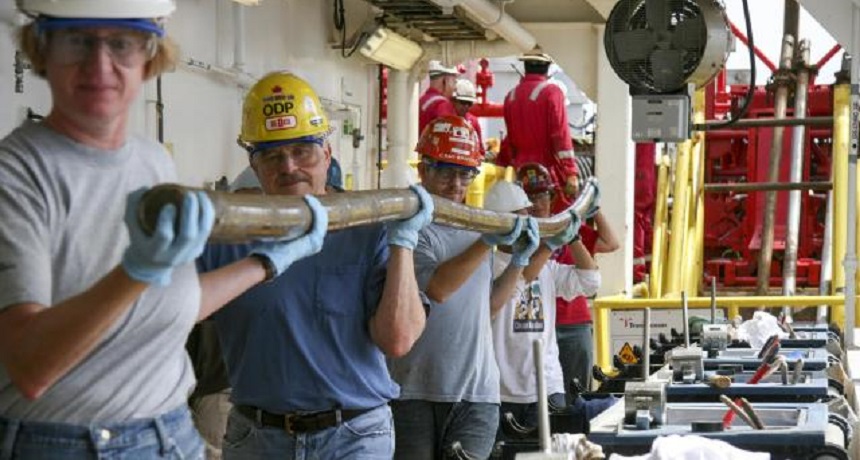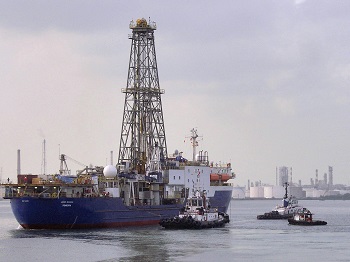Life’s ultra-slow lane is deep beneath the sea
Scientists are finding supposed ‘dead zones’ aren’t all that dead

Technicians on board the JOIDES Resolution bring in a sediment core retrieved from the bottom of the South Pacific.
Carlos A. Alvarez Zarikian
By Beth Geiger
Near the edge of continents, seafloor sediments teem with oxygen-breathing microbes. They live large on the feast of nutrients that wash off the land. They live so well, in fact, that they sometimes use up all the oxygen in the sediment. But what about places that are far from continents? With no source of nutrients, these distant, deep sea zones were largely dead. Or at least that’s what scientists had thought. Until now.
A new study finds a handful of ocean-bottom microbes persist in seafloor regions that are both remote and deep. Scientists refer to these regions as abyssal. What’s more, the new study reveals that with few microbes to use up the oxygen here, abyssal sediments contain a surprising amount of oxygen. These findings could change scientists’ understanding of Earth’s chemistry.
Steven D’Hondt and his colleagues published their study March 16 in Nature Geoscience.
Living, just barely
D’Hondt is a geobiologist at the University of Rhode Island in Narragansett. His team analyzed seafloor samples collected with a research ship called the JOIDES Resolution. Its scientists drilled into the ocean floor while the ship was stationed in a remote part of the South Pacific Ocean.

Sediment slowly builds up on the ocean floor. That far from a continent, it can take well more than one million years for just one meter (3.3 feet) of sediment to accumulate. So burrowing through this sediment lets scientists see into the past.
To their surprise, D’Hondt and his colleagues encountered microbes all the way down to the bedrock. The microbes, though, were breathing slowly. Very slowly.
Their numbers were also extremely low, D’Hondt says. “There were about 5,000 microbes per teaspoon of sediment,” he told Science News for Students. “More typical, near the continents would be 5 million or more microbes in that same teaspoon.”
Craig Moyer is a biologist at Western Washington University in Bellingham, where he specializes in the microbial ecology of oceans. The new data show than in remote, abyssal sediments, where microbes get little access to food, they “can exist for a very long time — thousands to millions of years — before they finally die,” he says.
Under such conditions, says Moyer — who was not involved in the study — these microbes will not be happy campers. “Microbes that are unfortunate enough to find themselves there are destined to starve for a long, long time,” he explains.
D’Hondt’s group is not the first to find evidence of slow-living microbes. Three years ago, a group from Aarhus University in Denmark reported something similar. At the time, one of those scientists, Hans Roy, noted that these organisms eat so little, grow so slowly and live so long that they challenge what it means to be alive. Indeed, he posited: “Maybe they never die.”
Surprise oxygen
The low number of starving, slowly breathing microbes helps explain the real surprise of the study: that the sediments in which they lived still contain oxygen. Too few organisms are living there to have consumed it all. Indeed, the team found oxygen through all 75 meters of sediment. It even showed up in the bedrock below. (There, oxygen oxidizes — or rusts — the rocks and sediments.)
“Our big conclusion is that much of the open oceans, about 37 percent, might be like this,” D’Hondt said. That is very significant, he explained, because the slow, steady motion of tectonic plates recycles those oxygenated sediments into Earth’s mantle. (The mantle is the thick layer below Earth’s outer crust.)
Until now scientists had assumed that the mantle contained little oxygen. But these findings open new questions about what the mantle is really like. “The notion of oxygenated geologic material getting supplied to the mantle is a surprise,” says Moyer.
Power Words
(for more about Power Words, click here)
abyssal A term that refers to the deepest parts of the ocean.
aerobic Requiring oxygen for respiration.
bedrock The thick, solid rock layer than underlies the soil and other broken, rocky materials on Earth’s surface.
chemistry The field of science that deals with the composition, structure and properties of substances and how they interact with one another. Chemists use this knowledge to study unfamiliar substances, to reproduce large quantities of useful substances or to design and create new and useful substances. (about compounds) The term is used to refer to the recipe of a compound, the way it’s produced or some of its properties.
continent (in geology) The huge land masses that sit upon tectonic plates. In modern times, there are six geologic continents: North America, South America, Eurasia, Africa, Australia and Antarctic.
ecology A branch of biology that deals with the relations of organisms to one another and to their physical surroundings. A scientist who works in this field is called an ecologist.
geology The study of Earth’s physical structure and substance, its history and the processes that act on it. People who work in this field are known as geologists. Planetary geology is the science of studying the same things about other planets.
mantle (in geology) The thick layer of the Earth beneath its outer crust. The mantle is semi-solid and generally divided into an upper and lower mantle.
microorganism A living thing that is too small to see with the unaided eye, including bacteria, some fungi and many other organisms such as amoebas. Most consist of a single cell.
microbe (Short for microorganism.) Living things that are too small to see with the unaided eye, including bacteria, some fungi and many other organisms such as amoebas. Most consist of a single cell.
nutrients Vitamins, minerals, fats, carbohydrates and proteins needed by organisms to live, and which are extracted through the diet.
oxidation (v. to oxidize) A process that involves one molecule’s theft of an electron from another. The victim of that reaction is said to have been “oxidized,” and the oxidizing agent (the thief) is “reduced.” Oxidation often involves oxygen atoms — but not always.
oxygen A gas that makes up about 21 percent of the atmosphere. All animals and many microorganisms need oxygen to fuel their metabolism.
respiration The process by which organisms produce energy from sugars, usually by taking in oxygen and releasing carbon dioxide.
sediment Material (such as stones and sand) deposited by water, wind or glaciers.
tectonic plates The gigantic slabs — some spanning thousands of kilometers (or miles) across — that make up Earth’s outer layer.







